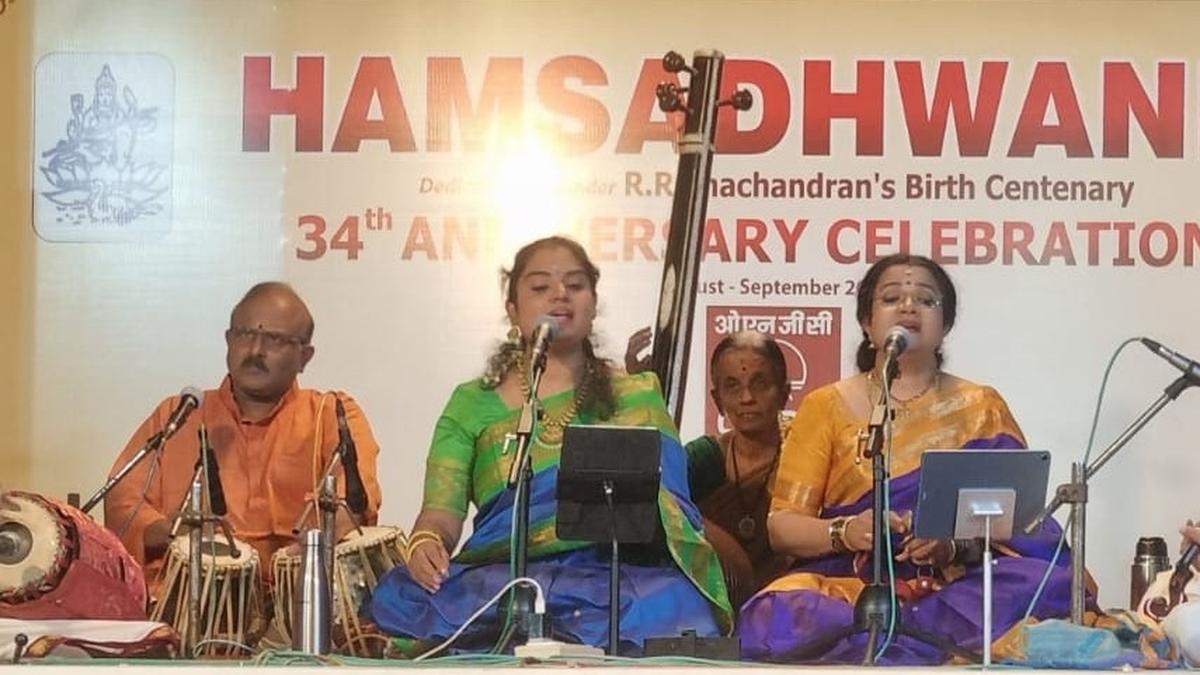
Vidya Kalyanaraman and Vasudha Ravi with Violinist Bombay Madhavan, B. Ganapathyraman on the mridangam and N. Sundar on the morsing and tabla.
| Photo Credit: Special Arrangement
Vasudha Ravi and Vidya Kalyanaraman collaborated recently for their Gokulashtami special thematic concert, âColours of Krishnaâ, hosted by Hamsadhwani. Their musical offering was a blend of conceptual depth, narrative clarity, and melodic excellence, painting a vivid and alluring picture of Krishnaâs multifaceted persona.
The chemistry between Krishna and colours is a captivating one, beginning with His name, which means black or dark blue. The golden crown, peacock feather, jewels and gems adorning him , Vanamala, flute, and the yellow attire are just a few examples of his flamboyant physical attributes.
âVanna maadangalâ (colourful mansions) is how Periyazhwar begins the chapter describing Krishnaâs birth, which, he says, triggered in the neighbourhood, wild celebrations like spilling oil and turmeric powder on one another. This, perhaps, is the origin of Holi, the festival of colours.
Vasudha and Vidya presented 12 songs in eight languages â Sanskrit and Tamil (three each), Hindi, Telugu, Kannada, Marathi, Brij and Malayalam. The first part showcased Krishnaâs myriad traits such as sweetness, naughtiness, leaving gopikas longing for his love, tackling Radhaâs fake anger and being a garland of radiant gems. The second half highlighted his roles such as the saviour, flautist, majestic bridegroom, charmer, omnipresent being and the heartthrob.
Steeped in bhakti
The recital opened with âMadhurashtakamâ in which Vallabhacharya extols Krishna as the embodiment of sweetness. The singers rendered the hymn with devotional fervour and serenity. However, it is worth noting that while many versions have it as âMadhuradhipatheâ in the fourth line, the correct phrasing should be âMathuradhipatheâ (the chief of Mathura, the city).
Oothukadu Venkata Kavi is an automatic choice for the theme and his âNeethaan mechikolla venumâ in Sriranjani describes Yasodhaâs exasperation in dealing with Krishnaâs mischiefs. The author quotes the foster mother as saying that one minute of Krishnaâs pranks seemed like an aeon. The lively swara exchanges at the pallavi line were in tune with the tone of the song.
Shift in mood
The Meera Bhajan âSaadho saadhoâ in Ahirbhairav brought out the cowherd girlsâ craving for Krishna. An evocative shloka in Mukhari came up next as a prelude to the Ashtapadi âVadasi yadi kinchidapiâ in the same raga. Krishna coaxes a sullen Radha by addressing her âPriye, charuseeleâ (O my love! O my virtuous one) and attempts to patch up with her. The lilting Annamacharya kriti in Chenjurutti âMuddugare yasodhaâ, which compares Krishnaâs acts to an array of gems of varied hues, provided a contrasting mood.
Vidya and Vasudha shared a brief alapana of Subhapantuvarali before rendering Purandaradasaâs âNeene anadhabandhuâ. It was a poignant exploration of Krishnaâs stature as the ultimate refuge, echoing the message of surrender from the Bhagavad Gita. (âMaam ekam saranam vrajaâ â surrender unto me only). The niraval and swara exchanges at âGati neene Krishnaâ underlined the ragaâs emotional depth, further enriching the presentation.
The duo then captured Krishnaâs mesmerising ways with the bamboo, presenting Bhanu Dasaâs gavlan abhang âVrindavani venuâ in raag Bhimplasi, with verve.
Vibrant tani
After alternately delineating another raga, this time Kamboji, the artistes sang a shloka as a prelude to Narayana Tirthaâs Kalyana Tarangam âAlokaye rukmini kalyana gopalamâ. It depicts Krishna as a bridegroom in all his splendour. A crisp swaraprastaram in two kalam at âDwarakapura mandapeâ was followed by an energetic thani by B. Ganapathyraman on the mridangam and N. Sundar on the morsing, with the latter donning a double role (tabla) in the concert.
Violinist Bombay Madhavan consistently matched the vocalists with mellifluous notes, while the percussion partnersâ rhythmic strokes enhanced the concert overall.
A Surdas bhajan on rasleela in Brij âGopi gopala balaâ in Gamanasrama; âKaakkai siraginileâ by Bharatiyar in Brindavana Saranga (expressing Krishnaâs omnipresence); Lalgudi Jayaramanâs Madhuvanthi thillana; and âKrishna krishna mukunda janardhanaâ by Poonthanam Nambudiri in Yamuna Kalyani offered further variety at the back end of a memorable concert.
